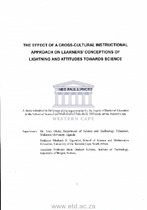| dc.description.abstract | This study looks at the effect of a cross-cultural instructional approach on the learners' conceptions of lightning and attitude towards science. It explored Basotho conceptions of lightning and thunder under the following themes: nature of lightning, protection against
lightning, animalistic/humanistic behaviour of lighting and nature of wounds inflicted by lightning. Fictitious stories were developed around these themes. It was important to develop stories around these themes because stories stimulate curiosity of the learner particularly if they are situated within their everyday experiences. Using an instrument named My Ideas about Lightning and Thunder (MILT), the learners' conceptions about lightning and thunder were collected. The MILT was structured in such a manner that it allowed learners to read a story and then to express agreement or disagreement with one or more statements which reflect their views on the story. Furthermore, ample space was provided for the learners to write and express their own views and explanations of the incidence described in the story. The study provides an overview of science education in Lesotho. In particular, it gave an outline of developments, apparent changes and dilemma experienced prior and after independence. It was against the background of curricular innovation and concomitant changes (Bishop, 1986) that the study was carried out Theoretical frameworks within multiculturalism were explored and were found to be appropriate to guide the study. These included contiguity theory, border-crossing, concept construction, collateral learning, collaboratively learning, collateral learning and others. These frameworks were applied in the analysis of the data. The learners were introduced to the scientific interpretation of lightning as presented in the Lesotho Junior Science curriculum using a cross-cultural instructional approach based on Jegede's (1995) cross-cultural pedagogical paradigm. The approach entails using a combination of knowledge about lightning prevailing in the learners' socio-cultural environment with school science. In other words, the science curriculum was situated in the context of learners' everyday expenence through a cross-cultural instructional approach that was sensitive to their socio-cultural environment. Specifically, the approach involves discussions, practical work, reading and lecture by the researcher and a traditional doctor To determine the effects of the treatment on the learners' conceptions and attitudes, a quasi-Solomon-3-Group design was adopted, where two of the three groups were exposed to the cross-cultural instructional approach. The learners' responses were qualitatively and quantitatively analysed in terms of a cognitive framework designed for the purpose. Based on the framework, it was found that: 1. Before being exposed to the cross-cultural instructional material, learners had both scientific and traditional conceptions of lightning and thunder. They believed among others in humanistic nature of lightning. Scientific conceptions held by the learners were those found at the interface between indigenous knowledge system
(IKS) and scientific understanding about lightning and thunder. 2. Some learners' conceptions about lightning and thunder oscillated between the scientific and traditional worldviews depending on the theme and context governing their viewpoint. In one theme, some learners responded in traditional worldview terms while others responded using scientific worldview terms. The degree of the oscillation (the extent to which a response was scientific or traditional) depended on how learners found the interpretation to be intelligible, plausible and fruitful (Strike and Posner, 1992). That was the case in all the three groups. After the intervention, some learners from both the experimental and control groups accepted both the scientific and tradition explanations about how lightning occurs, i.e. an instance of simultaneous collateral learning (Jegede, 1995). In other words, these learners used terms from the scientific and traditional worldviews in the same explanation of an incidence. The experimental and control group 2 (groups that received the cross-cultural instructional approach) were found to be more elaborate in their explanations of a scientific phenomenon than the group that was not exposed to the cross-cultural instructional approach.
5. All the groups were found to be positively inclined towards the scientific worldview. The learners attributed their perceptual shift and positive disposition towards science in terms of empirical nature of science, while at the same time they argued that cultural practices were based on belief. 6. All the stakeholders approached (i.e. traditional doctors, learners, teachers, expert of Sesotho language, and chairperson of the National Science Panel) are in support of the integration of the scientific and the traditional worldviews about lightning and thunder. However, they differ in the rationale and mode of integration. Some learners do not support the inclusion of witchcraft. They perceive it to be devious; the traditional doctor would like witchcraft and metaphysics to be included (inclusion of witchcraft would allow learners to know
which diseases are associated with witchcraft); the Sesotho expert and teachers would like to see a holistic approach (excluding witchcraft) adopted during the integration; the chairperson of the panel argues for the inclusion of only those aspects of culture that could be explained using the scientific worldview. The study recommends that: A systemic approach to integration should be adopted. All the stakeholders should deliberate on the rationale and mode of integration. 8. The implications of the integration on teacher training institutions' programmes as well as on teachers already in the field should be studied carefully. | en_US |

